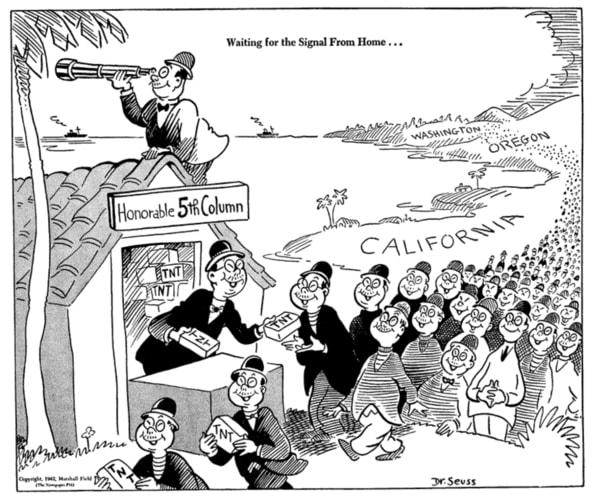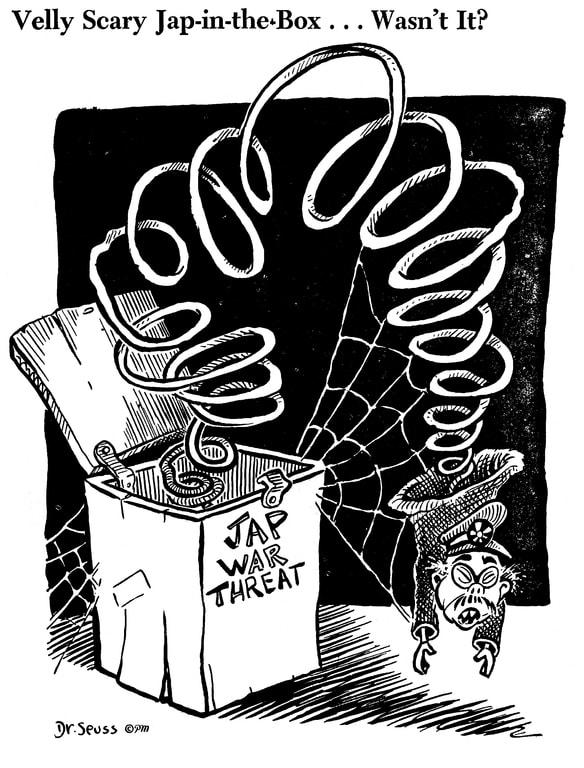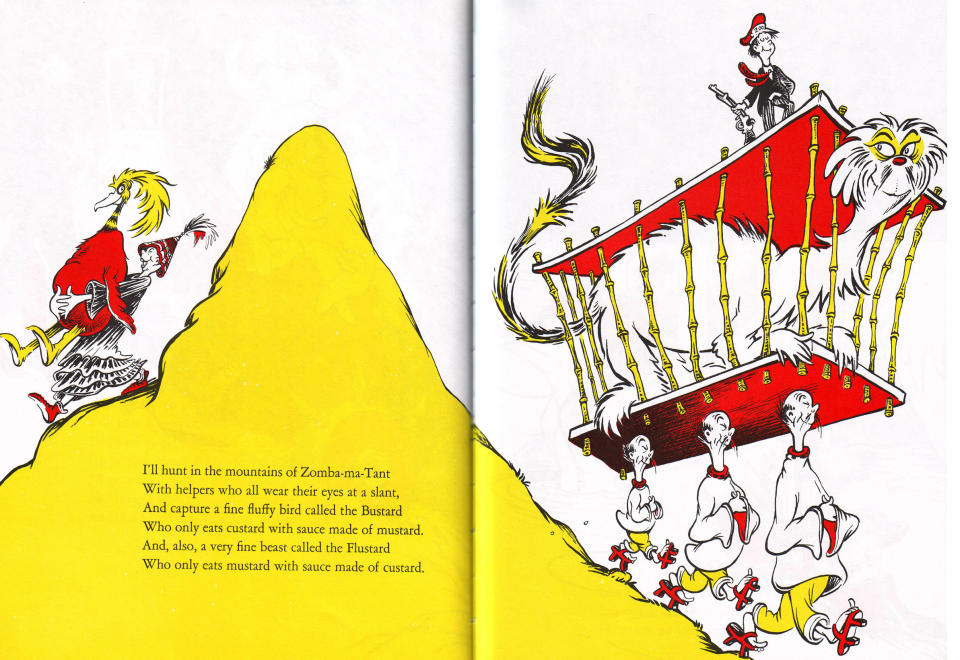Dr. Seuss' illustrations reveal just how ingrained anti-Asian racism is in America
- Oops!Something went wrong.Please try again later.
One illustration shows an Asian man with bright yellow skin, slanted eyes, a pigtail and conical hat, holding chopsticks and a bowl of rice over the words “a Chinaman who eats with sticks.” Another depicts three Asian men in wooden sandals carrying a bamboo cage on their heads with a gun-wielding white boy perched on top, next to the rhyme, “I’ll hunt in the mountains of Zomba-ma-Tant / With helpers who all wear their eyes at a slant.”
The drawings are from “And to Think That I Saw It on Mulberry Street” and “If I Ran the Zoo,” two of the six Dr. Seuss books that the company in charge of the author’s works announced last week will no longer be published because of their racist imagery, some of which includes stereotypical portrayals of Asian people.
Though Seuss’ art has been around for decades — “Mulberry Street,” his first children’s book, was published more than 80 years ago — widespread criticism of his work is relatively recent. Karen Ishizuka, chief curator at the Japanese American National Museum in Los Angeles, said Dr. Seuss' books have been able to get away with this racism for so long in part because of the persistence of anti-Asian racism in the U.S. since the 1800s.
“No doubt, the long-standing prevalence of racist Asian imagery within the larger widespread anti-Asian sentiment in the U.S. added to the delayed response to Dr. Seuss’ racism,” Ishizuka told NBC Asian America. “Generations of Americans have grown up with depictions of Asians that ranged from grotesque to comical. Especially when buffered in Seuss’ rhyming verse, his racist depictions, already normalized in U.S. society, are put forth in jest as if they are innocuous.”
Dr. Seuss eventually edited the image from “Mulberry Street” in 1978, more than 40 years after it was first published, by removing the yellow pigment from the Asian man’s skin as well as the pigtail, and changing “Chinaman” to “Chinese man.” But the character’s slanted eyes remained.

His racism wasn’t limited to children’s books. Dr. Seuss, the pen name for Theodor Seuss Geisel (who died in 1991, at 87), also perpetuated harmful Asian stereotypes in a series of political cartoons. From 1941 to 1943, he published more than 400 cartoons for the New York newspaper “PM,” many of which displayed anti-Japanese racism during World War II.
One of his most infamous political cartoons suggested that Japanese Americans were a threat to the U.S. after the bombing of Pearl Harbor. Titled “Waiting for the Signal From Home … ,” the cartoon depicts countless characters with the same slanted eyes and glasses — who are meant to be Japanese Americans — marching along the West Coast and waiting to pick up TNT from a store labeled “Honorable 5th Column.” The cartoon was published on Feb. 13, 1942 — just six days before President Franklin D. Roosevelt issued Executive Order 9066, which led to the incarceration of more than 110,000 individuals of Japanese descent.
Some of Dr. Seuss' other political cartoons during this time use the slur “Jap,” depict Japanese people as animals, and include captions that replace the letter R with the letter L to mock the way Japanese people speak.

Ishizuka is working on developing a new core exhibit for the museum that she hopes will bring greater attention to Dr. Seuss’ political cartoons by featuring original drawings from the library of the University of California, San Diego — including “Waiting for the Signal From Home ... ”
“It’s important to draw attention to the racist images in Dr. Seuss’ cartoons and children’s books because they’re almost insidious,” she said. “The harm they cause is more difficult to identify than when someone calls you a ‘Jap’ to your face. It’s harder to combat.”
Philip Nel, a children’s literature scholar and English professor at Kansas State University, said another reason why Dr. Seuss’ reckoning took so long is that people have excused his racism, especially the anti-Japanese propaganda he created during WWII, as a reflection of the time he was living in. But Nel, the author of several books, including “Was the Cat in the Hat Black? The Hidden Racism of Children’s Literature, and the Need for Diverse Books,” said this explanation doesn’t hold up.
“The ‘man of his time’ narrative isn’t a great argument because to make that claim is profoundly ahistorical,” Nel said. “All people in every moment don’t think the same. There were plenty of white Americans during that time who were not spreading the rhetoric that he was.”
Nel said the decision by Dr. Seuss Enterprises to cease publishing the books — which in addition to “Mulberry Street” and “If I Ran the Zoo,” also include “McElligot’s Pool,” “On Beyond Zebra!”, “Scrambled Eggs Super!” and “The Cat’s Quizzer” — is owed to the longtime push for diverse books in the U.S., as well as recent movements for racial and social justice.

“This is the culmination of decades of work arguing for diverse works and against books that caricature people of color,” Nel said. “The Black Lives Matter movement, I think, has also brought into focus the need for diverse books for young readers. It’s reminded people that one place where justice happens is through representation — acknowledging positive examples and calling out negative ones.”
Dr. Seuss’ image as a children’s literary icon has also delayed the reckoning over his racism. “He’s a symbol of American childhood,” Leslie Ito, the mother of two from Southern California, said.
In 2017, Ito’s children, Rockett and Zoe, who were 11 and 10 at the time, created and distributed flyers to their classrooms on Read Across America Day — which was founded by the National Education Association to coincide with Dr. Seuss’ birthday — to educate their peers about Dr. Seuss’ racist work.
“Ever since the kids started elementary school, my husband and I decided it was important that we taught them about the darker side of Dr. Seuss,” Ito said of her children, who are Chinese and Japanese American. “We did this every year around Read Across America Day, and one year the kids came up with the idea to create a flyer, unprompted.”
The kids came home that day telling their parents they got in trouble and had their flyers confiscated, and that evening Ito and her husband received an email from the school saying the flyers were inappropriate.
In recent years, Read Across America Day has made an effort to distance itself from Dr. Seuss.
Though Ito said she understands the hesitancy to criticize Dr. Seuss, she’s proud that her children contributed to today’s acknowledgment of Seuss’ past.
“When I used to Google ‘Dr. Seuss and racism,’ our story would pop up first for a couple of years, but now it’s completely buried under countless stories,” Ito said. “That excites me because it shows that more people than Rockett and Zoe care about this issue.”

